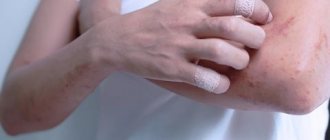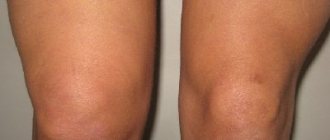Neuritis
Neuritis
is an inflammation of the peripheral nerve trunk.
The peripheral nervous system refers to the nerve structures outside the brain and spinal cord (which are in turn called the central nervous system). Excitation (signal) is transmitted along the nerves, allowing the central nervous system to receive information about the state of all organs and systems of our body and control muscle contractions. The tissues of various organs are penetrated by nerve endings, which are connected to the brain, and in most cases to the spinal cord using bundles of nerve fibers enclosed in a sheath of connective tissue. Such bundles are called nerves, and large nerves are called nerve trunks.
With neuritis, nervous tissue is involved in the inflammatory process. This leads to the fact that the signal in some part of the nerve passes worse or does not pass at all. Accordingly, the sensitivity of any area may be lost and the mobility of the muscles innervated by the affected nerve may decrease.
Causes of the inflammatory process
Pathology appears after bacterial and viral infections or under the influence of external factors and internal processes in the body. The most common reasons are:
- consequences of ARVI, sore throat, bronchitis, influenza;
- previous injuries;
- pathological changes in blood vessels;
- poisoning: alcohol, toxic substances;
- diseases of the endocrine glands: thyrotoxic goiter, diabetes mellitus.
The disease also occurs due to compression of the nerve trunk. The reason may be the constant adoption of an uncomfortable posture. Thus, pianists and cellists often suffer from neuritis of the median nerve of the hand. Treatment will help avoid complete loss of sensitivity in the fingers or hand, and atrophy of muscle tissue.
Causes of the disease
Most often, optic neuritis develops with multiple sclerosis and is its first manifestation. The basis of the inflammatory process in this case is demyelination, or destruction of the myelin sheath of the nerve. Damage to the optic nerve is also provoked by other autoimmune pathologies: systemic lupus erythematosus, Sjogren's syndrome.
Diseases associated with serum immunoglobulin G to myelin-oligodendrocyte glycoprotein (MOG-IgG), in particular acute disseminated encephalomyelitis, also lead to demyelination and, as a consequence, optic neuritis.
Axons and neurons of the optic nerve are destroyed not only as a result of demyelinating processes, but also against the background of other diseases. These include:
- inflammation of the eyeball and/or orbit;
- inflammatory diseases of the brain;
- infectious processes in the nasopharynx;
- sarcoidosis, granulomatosis;
- acute cerebrovascular accident;
- endocrine pathologies – thyrotoxicosis, diabetes mellitus;
- specific infections - tuberculosis, syphilis, influenza.
Optic neuritis can be a consequence of eye injury, traumatic brain injury, toxic damage - in most cases it is poisoning with methyl alcohol, lead, and sometimes helminthic infestations. May be provoked by complicated pregnancy.
Facial neuritis: symptoms and treatment
In a multifactorial disease of the peripheral nervous system, 7 pairs of cranial nerves are affected. Often the provoking factor is hypothermia of the face. The patient has weakness of the facial muscles.
Signs of asymmetry:
- lack of ability to wrinkle forehead;
- the corner of the mouth is lowered;
- failure to close the eyelids on the affected part;
- failures when trying to smile or whistle;
- speech ceases to be intelligible.
Depending on the level of damage, other symptoms are observed in the treatment of facial neuritis: dry eyes or tearfulness when eating, increased sensitivity to sounds, a pronounced nasolabial fold on the affected side.
To relieve inflammation, medications are used, physiotherapy and therapeutic massage, and acupuncture are performed. Physiotherapeutic procedures are prescribed from the 7th to 10th day of treatment to improve blood circulation and prevent the development of muscle contractures. Therapeutic massage for the treatment of facial neuritis is indicated from 2–6 weeks of the disease, depending on the course of the disease and the individual characteristics of the patient’s body.
Drug treatment of facial neuritis involves taking several groups of medications. The list may include:
- anti-inflammatory drugs: glucocorticosteroids;
- diuretics - to relieve swelling during an additionally prescribed diet;
- B vitamins;
- antispasmodics and analgesics;
- means for symptomatic treatment: for dry eyes, antibacterial drugs, for herpes, acute respiratory viral infections - antiviral drugs.
If the treatment of facial nerve neuritis is carried out incorrectly or at the wrong time, a complication may occur in the form of contracture of the facial muscles. Spontaneous twitching of the facial muscles is observed; when eating, the palpebral fissure narrows. The cheek on the affected side is thicker. In this case, only plastic surgeons can eliminate the deformity.
Herpetic encephalitis
The most common sporadic encephalitis in Western Europe is herpes simplex encephalitis (HSVE). The main symptoms of this deadly disease include headaches, fever, as well as various quantitative and qualitative disturbances of consciousness. If a patient is suspected of having herpetic encephalitis, antiviral therapy with Acyclovir should be carried out. Without treatment, the disease can be fatal, and any delay in starting antiviral therapy can cost the patient his life.
Treatment of neuritis of the nerve: ulnar, radial and median
The mobility of the hand is impaired. It is impossible or difficult to bend and straighten it. Moving your fingers hurts. There is a tingling or numbness sensation in the affected area.
Neuropathy occurs with fractures, dislocations of the bones of the shoulder, forearm, hand, or compression in the area of fibrocystic canals. Compression is most often formed as a result of prolonged trauma. In the area of the cubital canal, it is provoked by: systematically repeated flexion movements of the elbow, constant support when working with the elbow on a machine, table, workbench.
In the area of Guyon's canal, compression occurs due to the use of a cane, frequent cycling, motorcycling, or regular work with the same tool: screwdriver, pliers, pliers, jackhammer. Neuralgia can also be caused by:
- tumor;
- enlarged lymph nodes;
- aneurysm of a nearby vessel;
- arthritis or arthrosis of the elbow joint.
When a nerve is damaged, the patient experiences pain, muscle strength decreases, and movement disorders occur. To diagnose, the doctor performs a physical examination, prescribes tests and an MRI.
Treatment for median nerve neuritis, like ulnar neuritis, depends on the cause of the problem. If compression occurs in the area of the cubital canal or Guyon's canal, reduce the compression of the fibers during movement by applying fixing devices: bandages, splints, orthoses. Movements that cause compression should be avoided.
Non-steroidal anti-inflammatory drugs are prescribed to treat ulnar nerve neuritis and reduce symptoms in the form of swelling and pain. Massage and acupuncture have a positive effect on the nervous system. Physiotherapy helps with neuropathy and nerve compression due to fractures and injuries.
However, the disease must be treated after the first signs appear. As soon as one of the symptoms of hand neuritis appears, treatment begins. Otherwise, conservative methods will become ineffective.
Disease prevention
To prevent optic neuritis, it is recommended to give up bad habits, promptly treat infectious diseases, avoid eye and head injuries, and visit specialized doctors in the presence of chronic pathologies.
Article sources:
- Retrobulbar optic neuritis. Kukhtik S.Yu., Popova M.Yu., Tantsurova K.S. Bulletin of the Council of Young Scientists and Specialists of the Chelyabinsk Region, 2016
- Visualization of the optic nerve in the diagnosis and monitoring of retrobulbar neuritis. Yuryeva T.N., Burlakova E.V., Khudonogov A.A., Ayueva E.K., Sukharchuk O.V. Acta Biomedica Scientifica, 2011. p. 133-136
- Modern view on the problem of optic neuritis (systematic review). Krivosheeva M.S., Ioileva E.E. Saratov Scientific and Medical Journal, 2021. p. 602-605
- Results of treatment of optic neuritis. Latypova E.A. Saratov Scientific and Medical Journal, 2021. p. 875-879
Our methods of treating neuritis
Physiotherapy
from 1200 rub.
Massotherapy
from 500 rub.
Shock wave therapy
from 1900 rub.
Meningitis
Most often, bacterial meningitis is caused by streptococci (Streptococcus pneumoniae), Listeria (Listeria monocytogenes) and meningococci (Neisseria meningitidis). Symptoms of the disease include headaches, fever, nausea and vomiting, as well as so-called meningism, or stiff neck muscles. In very young as well as elderly patients, the symptom of meningism may be absent. Like viral diseases, bacterial meningitis requires immediate treatment, rapid diagnosis and qualified treatment of the patient in the intensive care unit.
Diagnostics and therapy
When a patient comes in, the doctor performs functional tests. At the Innovative Medical Center, consultations are carried out by high-level specialists, doctors and candidates of medical sciences.
Regardless of the form of the pathology, physiotherapy and medication are prescribed. The latter enhance the effect of drugs during the treatment of neuritis of the femoral nerve and other types of lesions of the nervous system. The procedures do not injure the skin and soft tissues, do not cause complications, and act locally.
To recover from sciatica, a complex of physiotherapeutic methods is often used. In our clinic we carry out:
- Shock wave therapy (SWT). It relieves swelling, improving the effect of medications in the treatment of facial neuritis. When a nerve is pinched in the carpal tunnel, it removes fibrosis and tendon deposits.
- HIVAMAT - massage with a pulsating electrostatic field. Physiotherapy helps eliminate swelling and pain, inflammation, and improves trophism.
- Acupuncture. Usually prescribed for the treatment of neuritis of the facial nerve. Reviews from satisfied patients indicate a rapid recovery after therapy. The procedure reduces swelling along the movement of the nerve trunk, restores sensitivity and nerve patency, and relieves inflammation.
- Massotherapy. Indicated for almost all types of neuralgia, including the treatment of traumatic neuritis. In the first days of illness, professional massage therapists perform it in a gentle manner locally, depending on the area of inflammation. For example, during the treatment of trigeminal neuritis, the collar area, the occipital part and the affected area of the face are rubbed and stroked.
A positive result is possible only with complex treatment of neuritis, eliminating the symptoms and causes of its occurrence. Success depends on many factors, in particular on the stage of the disease, which is diagnosed after examining the patient by a neurologist. To quickly get rid of the problem without surgery, it is important to promptly contact competent specialists for help.
The article was reviewed by Professor, Dr. med. Sciences, neurologist Ronami V.G.
Pain due to inflammation
In addition, a disease such as inflammation or neuritis of the facial trigeminal nerve makes itself felt with attacks of pain of a very diverse nature:
- cutting,
- burning,
- pricking,
- tearing
- shooting, etc.
In this case, the area of pain does not always correspond to the area of innervation and can spread to the lower jaw, cheeks and chin.
Pain may be accompanied by:
- muscle spasms (facial, chewing),
- the appearance of nasal discharge,
- development of hypersalivation,
- increased lacrimation.
Lack of sensation in the tongue, lips and chin
With inflammatory damage to the trigeminal nerve, not only the entire nerve can be damaged, but also its individual branches. This is why numbness and pain can occur in various areas of the face. For example, when the lingual branch of the nerve is inflamed, patients complain of pain and sensitivity disturbances in the anterior part of the tongue, and when the mental branch is damaged, in the area of the lips and chin.
Pain when laughing, chewing, brushing teeth and shaving
Pain due to neuritis of the maxillary trigeminal nerve can intensify with touching, chewing, laughing and with changes in temperature. That is why patients, trying to prevent the recurrence of painful attacks, avoid excessive mobility and prolonged conversations, and refuse brushing their teeth and shaving.
Cost of treatment of neuritis
| Services list | Price, rub |
| Initial appointment (examination, consultation) with a neurologist, Doctor of Medical Sciences | 2200 |
| Initial appointment (examination, consultation) with a neurologist | 1600 |
| UVT 1 procedure | 2000 |
| HIVAMAT up to 15 min./1 body unit | 2200 |
| HIVAMAT up to 15 min./2 body units | 3200 |
| Massage of one lower limb (20 min.) | 2200 |
| Massage of two lower limbs (30 min.) | 3000 |
| General therapeutic massage (120 min.) | 6900 |
| Corporal acupuncture | 2700 |
| Auricular acupuncture | 1600 |
Contact us
Call now
8 (495) 803-27-45
Make an appointment through our service
Make an appointment
Multiple sclerosis
The best known autoimmune disease is multiple sclerosis (MS). It is a chronic inflammatory demyelinating disease with axonal damage to the central nervous system. The cause of MS is unknown, but the success of immunosuppressive treatment using disease-modifying drugs has suggested an autoimmune pathogenesis.
Common symptoms of MS are visual disturbances, numbness, concentration problems, fatigue, speech problems, coordination problems, spasticity, urination problems, sexual problems, swallowing problems, and double vision. However, today modern drugs for the treatment of multiple sclerosis make it possible to well control the course of the disease; moreover, the earlier the diagnosis is made and therapy is selected, the more successful the treatment is. On average, 80 out of 100 patients remain functional ten years after the onset of the disease.
Who will treat you?
Bogdanov Vadim Yurievich
Chief traumatologist-orthopedist..
Read more
Ronami Valery Guseinovich
neurologist, reflexologist, chiropractor, professor, doctor of medical sciences.
More details
Dremin Evgeniy Vitalievich
neurologist, reflexologist, chiropractor.
Read more
Repeated appointments with a neurologist based on examination results in our clinic are free.
Guillain-Barre syndrome
Guillain-Barré syndrome is a rare disease of the central nervous system. This is acute or subacute, often post-infectious polyradiculoneuritis, which reaches its peak of development within a few days or weeks. Multifocal demyelination and/or axonal damage to peripheral nerves and spinal roots occurs. Since the decline in polio incidence in the Western world, Guillain-Barré syndrome is the most common cause of acute flaccid paralysis syndrome. The disease can develop in a patient at any age and usually begins after infections such as Campylobacter jejunal, Mycoplasma pneumoniae, cytomegalovirus or Epstein-Barr virus. The overall mortality rate is about 2-3%, and approximately 20% of patients who recover from this disease continue to have neurological deficits. Approximately 90% of patients initially experience nonspecific symptoms, such as itchy paresthesia of the legs and arms, back pain, and later flaccid paralysis, which spreads to the upper and lower extremities of the patient over a period of several hours to several days. Thus, a patient who could walk in the morning finds himself bedridden in the evening with paralysis of the entire body. As part of the treatment of Guillain-Barré syndrome, the patient is prescribed symptomatic and immunomodulatory therapy, which uses immunoglobulins and immune adsorption, as well as plasmapheresis.
The prevalence of inflammatory diseases affecting the central nervous system is very high. Early diagnosis and highly differentiated therapy are extremely important for further prognosis. As in the case of stroke, in inflammatory diseases of the central nervous system the rule “Time is Brain” applies, which means that the loss of time is tantamount to the loss of the human brain! Fast and correct treatment can save lives!







